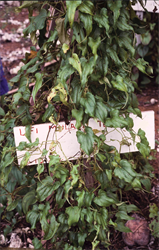- Widespread. Present wherever Dioscorea alata and other species is grown.
- Impact unknown. Caused by Yam mild mosaic virus, second most important after Yam mosaic virus disease (see Fact Sheet no. 526). Symptoms vary: leaves with mild yellowing, yellow and green spots, mottles and mosaics, severe leaf distortions and stunting.
- Spread: aphids by flight and on the wind. Transmission in non-persistent manner - aphids acquire YMMV quickly, transmit it over next few hours, then lose ability to infect. Spreads also in sets for propagation.
- Biosecurity: risk from unofficial introductions, trade in yams, and possibility of different strains.. Official movement of germplasm should always follow the FAO/IPBGR Technical Guidelines.
- Biocontrol: none.
- Cultural control: choose only healthy (often largest) tubers for sets; rogue plants that show early symptoms to prevent them being used as sets next season. Weed to remove infestations of aphids; collect and destroy or eat undersized tubers at harvest. Resistant lines may be available through international breeding programs.
- Chemical control: not appropriate for this disease.







